NITs: A Practical Overview: Navigating the Basics
Chat with MASLD AI

Hi, I am MASLD AI.
Suggested Questions :

MASLD AI 08:29 PM

In this episode, Christie Morrison breaks down the fundamentals of non-invasive testing (NITs) for evaluating patients with fatty liver disease, including MASLD and MASH. She explains the key differences between steatosis (MASLD) and steatohepatitis (MASH), highlighting how non-invasive tests can replace liver biopsy for staging fibrosis. Christy reviews common tools like FIB-4, NAFLD fibrosis score, Enhanced Liver Fibrosis (ELF) score, transient elastography (FibroScan), and MR elastography, and outlines how to choose the right test based on patient factors such as co-morbidities, geography, access to labs, and imaging availability. The episode also emphasizes the importance of fibrosis risk stratification, interpreting FIB-4 cutoffs, and monitoring liver stiffness or ELF scores after initiating lifestyle or pharmacologic treatment—including newer therapies like resmetirom. This is a must-watch for APPs, GI clinicians, and primary care providers seeking to improve care pathways and outcomes in patients with metabolic liver disease through practical, accessible strategies for fibrosis detection and management.
Related Podcast

APP Insight: Common Questions from Primary Care Providers About MASH

In this informative video, Michelle Barnett, PA-C, a hepatology expert based in Colorado Springs, answers frequently asked questions about elevated liver enzymes in the context of MASH (Metabolic Dysfunction–Associated Steatohepatitis) and MASLD (Metabolic Dysfunction–Associated Steatotic Liver Disease). She breaks down how to interpret common liver enzyme patterns—such as ALT greater than AST versus AST greater than ALT—and what these patterns may indicate, from MASH to alcohol-related liver disease and other potential causes like autoimmune hepatitis or drug-induced liver injury. Michelle outlines how to perform a thorough workup, including patient history, medication review, and physical exam findings, and emphasizes the importance of using tools like FIB-4 and abdominal ultrasound to assess for fibrosis and portal hypertension. The discussion also covers the clinical value of GGT, alkaline phosphatase, bilirubin, albumin, and platelets in evaluating liver function. Michelle shares practical guidance on when to refer patients to hepatology and how to monitor liver enzymes over time, particularly in those undergoing lifestyle changes or pharmacologic treatment. This comprehensive Q&A is an essential resource for providers managing patients with suspected or confirmed metabolic liver disease.
Watch Now
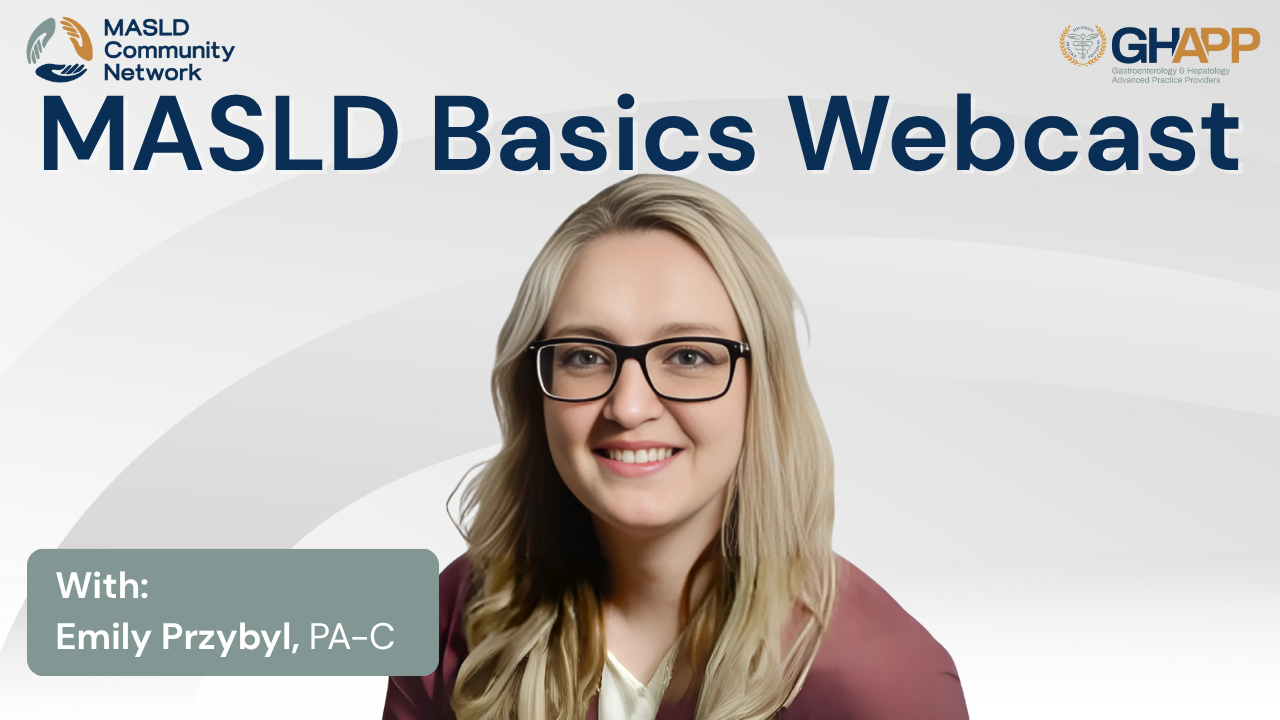
MASLD Basics With Emily Przybyl

Emily Przybyl, PA-C, breaks down the basics of Steatotic Liver Disease (SLD) and the updated MASLD/MASH nomenclature—what changed, why it matters, and how to apply it in daily practice. You'll learn how to distinguish MASLD, MetALD, and alcohol-associated liver disease, interpret alcohol exposure (weekly vs. daily intake), and recognize non-metabolic causes of steatosis (DILI, monogenic disorders, viral hepatitis). Emily walks through primary care–friendly risk assessment using FIB-4, when to order VCTE/FibroScan or the ELF test, when to refer to hepatology, and when liver biopsy is still the right move in discordant cases. Using a real patient case, Emily demonstrates a stepwise chronic liver disease workup (viral serologies, iron studies, autoimmune markers, celiac, A1AT, HIV, lipids, A1C, and PEth for alcohol), plus how ultrasound findings (steatosis, smooth contour, spleen size) inform staging. She reviews natural history and progression (who’s at risk to advance to fibrosis/cirrhosis), the roles of genetics and the gut microbiome, and practical counseling on lifestyle modification—BMI/waist thresholds by ethnicity, cardiometabolic risk control, and culturally sensitive nutrition and exercise plans. Perfect for APPs, primary care, and hepatology teams looking for a clear, actionable primer on MASLD/MASH.
Watch Now
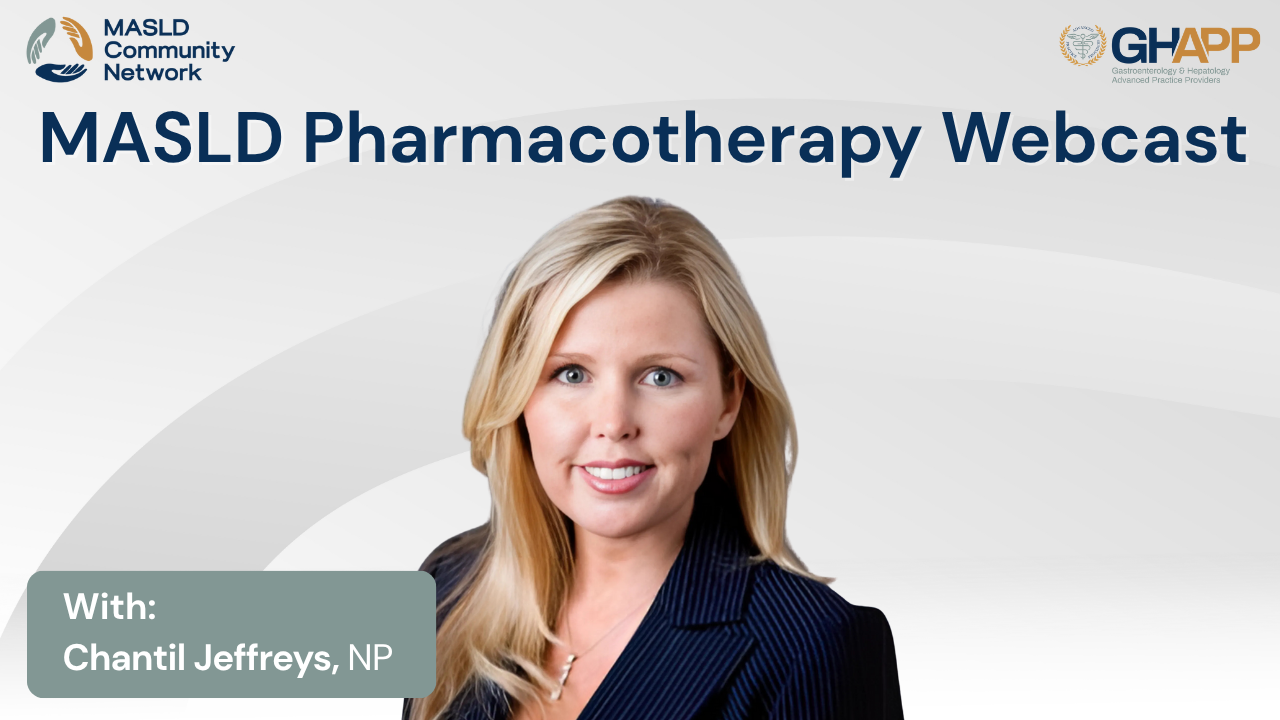
MASLD Pharmacotherapy With Chantil Jeffreys

In this MASLD Community Network webcast, Chantil Jeffreys, NP, walks through a practical framework for pharmacotherapy in MASLD/MASH—from lifestyle-first approaches to the evolving role of GLP-1 receptor agonists and bariatric/endoscopic options. She clarifies common misconceptions (e.g., statins are safe—and beneficial—for patients with fatty liver), reviews evidence and real-world considerations for vitamin E and pioglitazone, and explains where resmetirom (Rezdiffra) fits today for non-cirrhotic MASH with F2–F3 fibrosis—including monitoring, drug–drug interactions, and documentation tips that support payer approval. The session also covers cardiovascular risk reduction, peri-procedure guidance for GLP-1s, and practical strategies for staging and follow-up so clinicians can confidently personalize therapy and improve outcomes.
Watch Now
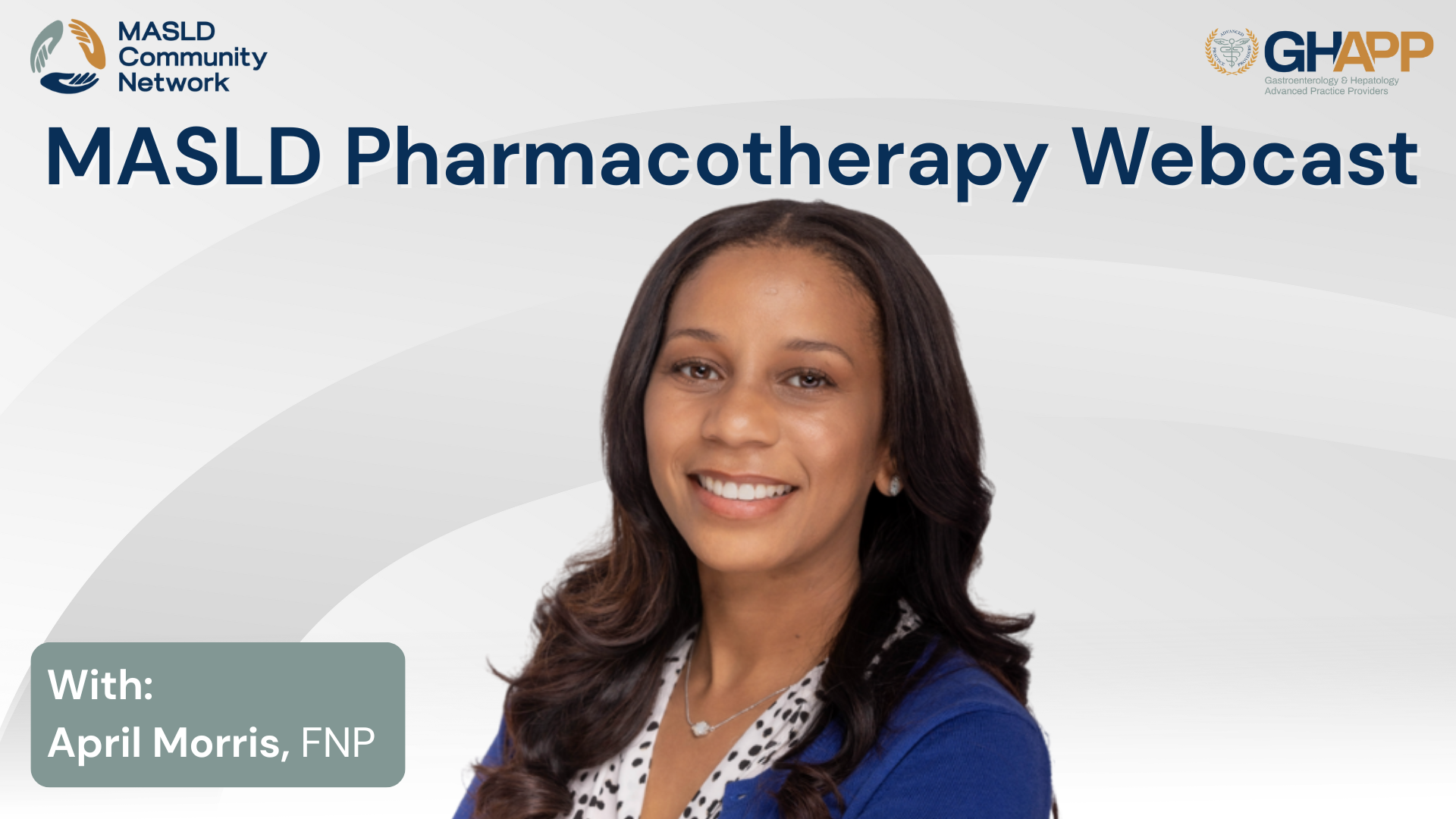
MASLD Pharmacotherapy With April Morris

Join April Morris, FNP, a hepatology and endocrinology nurse practitioner, for a comprehensive review of MASLD pharmacotherapy as part of the GHAPP MASLD Community Network. This expert-led session outlines a three-pronged strategy for managing Metabolic Dysfunction-Associated Steatotic Liver Disease (MASLD) and MASH, focusing on obesity reduction, cardiometabolic risk control, and liver-directed treatment. April walks through first-line lifestyle approaches, highlights key pharmacologic agents like GLP-1 receptor agonists, and explains their mechanisms and clinical relevance—including the groundbreaking data from the semaglutide trials showing resolution of MASH and improvement in liver fibrosis. The session also reviews the role and limitations of vitamin E and pioglitazone, emphasizing their risks in patients with diabetes or cardiovascular disease. The spotlight then shifts to resmetirom (Rezdiffra), a thyroid hormone receptor beta agonist FDA-approved for adults with non-cirrhotic NASH and moderate-to-advanced fibrosis (F2–F3). April explains the MAESTRO-NASH trial endpoints, clinical efficacy, common side effects, and appropriate patient selection. Learn how resmetirom improves fatty acid oxidation, reduces hepatic fat and fibrosis, and the key drug–drug interactions and statin dose considerations to manage during treatment. The discussion concludes with practical tips for monitoring, non-invasive staging (FibroScan, ELF, MRI-PDFF), and the evolving guidance on treatment duration, safety labs, and insurance barriers. This session is essential for clinicians navigating the growing landscape of therapeutic options in MASLD/MASH care.
Watch Now
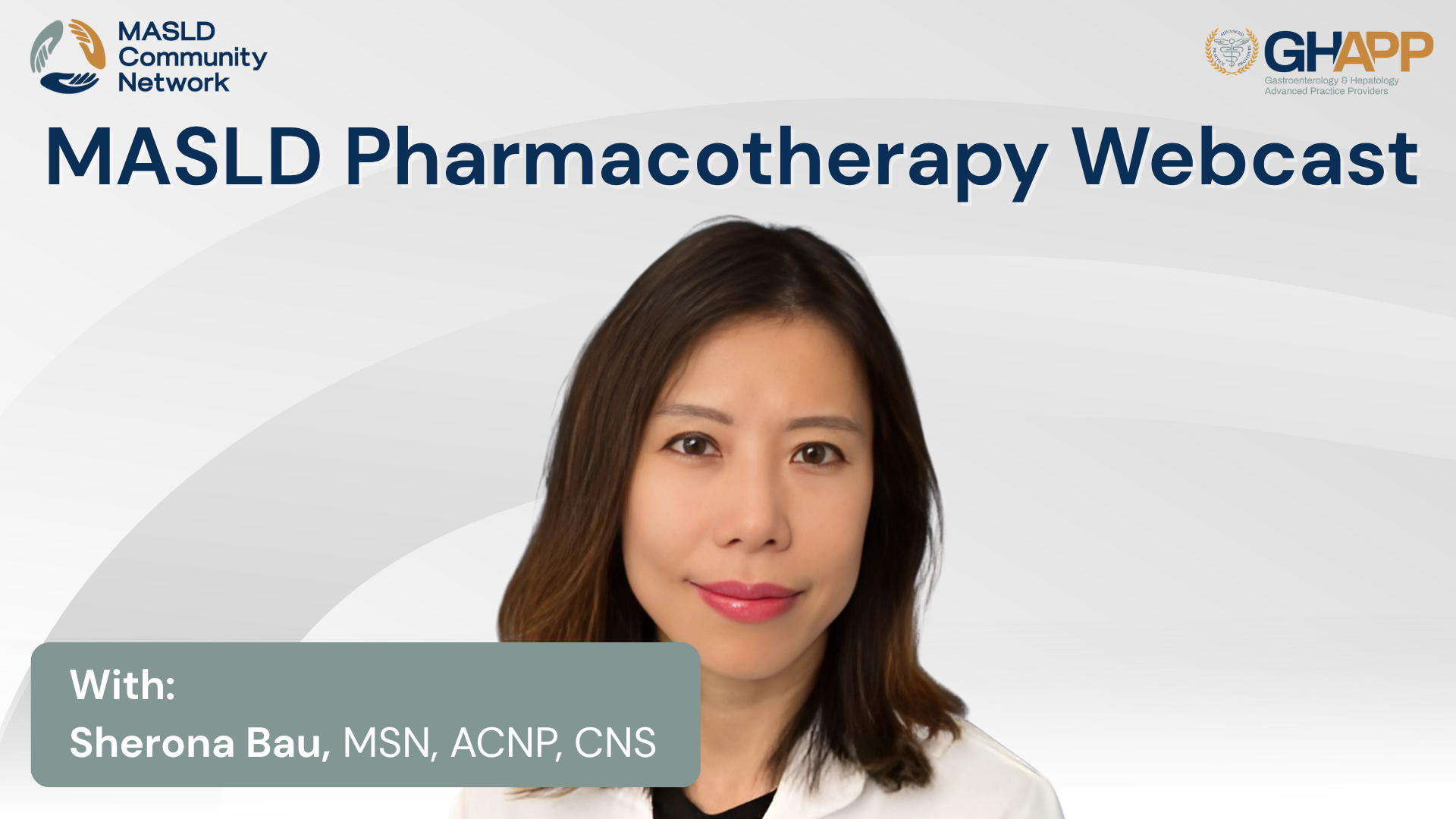
MASLD Pharmacotherapy

In this dynamic and highly informative session, Sherona Bau, NP, presents a comprehensive overview of pharmacotherapy in MASLD and MASH, breaking down current treatment strategies and emerging therapies for patients with metabolic dysfunction-associated steatotic liver disease. This presentation, part of the MASLD/MASH Community Network, begins by contextualizing the recent nomenclature shift from NAFLD/NASH to MASLD/MASH and its clinical implications. Sherona explores lifestyle intervention targets, including Mediterranean diet, weight loss goals based on fibrosis stage, and the role of GLP-1 and GIP receptor agonists in improving liver health. She highlights the ESSENCE trial results for semaglutide, discusses the only FDA-approved therapy to date—resmetirom (Rezdiffra)—and explains its mechanism of action via thyroid hormone receptor beta activation. The session dives deep into efficacy data from the MAESTRO-NASH trial, side effect profiles, drug–drug interactions, and monitoring recommendations. She also previews a pipeline of promising agents in phase 2 and 3 trials—including tirzepatide (GLP-1/GIP), cotadutide (GLP-1/GR), pemvidutide (GLP-1/GIP), and retatrutide (GLP-1/GIP/GR)—offering insight into what’s next in the evolving treatment landscape. This is a must-watch for hepatology and endocrinology clinicians focused on the future of fatty liver management.
Watch Now
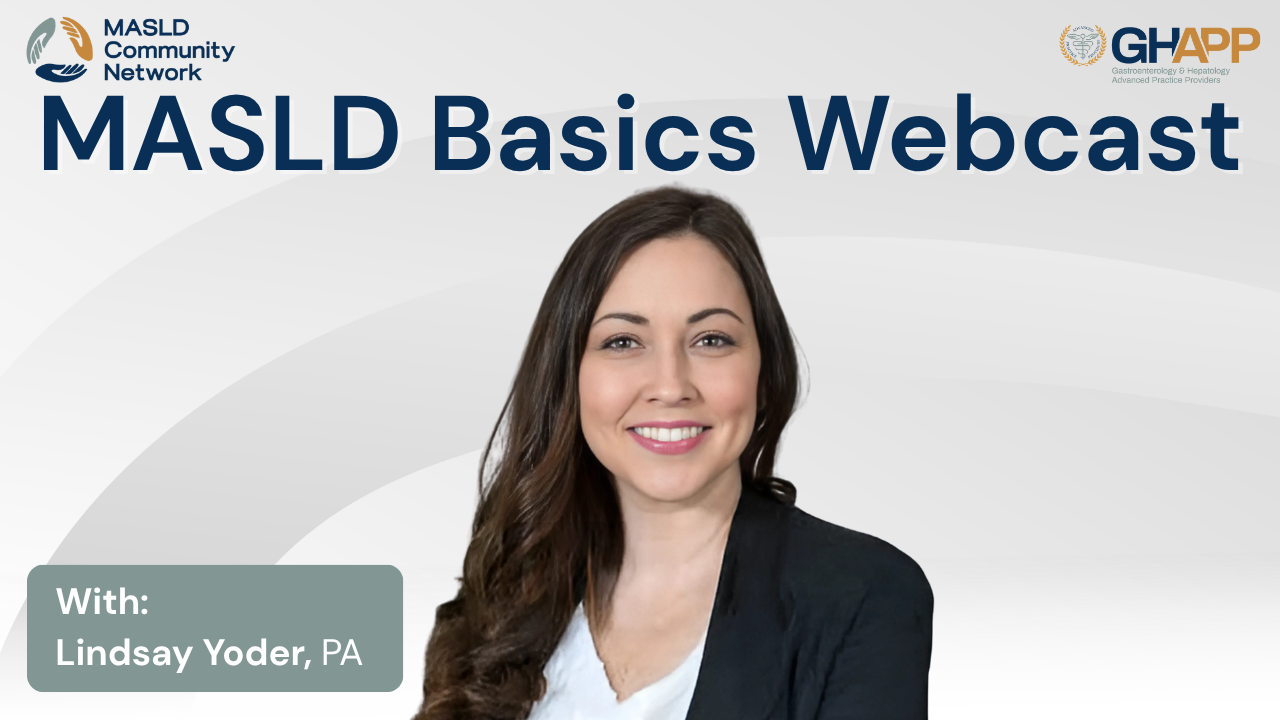
MASLD Basics With Lindsay Yoder

Lindsay Yoder, PA, Indiana University, delivers a clear primer on the new MASLD/MASH nomenclature and how it fits within the broader Steatotic Liver Disease (SLD) spectrum—including MetALD and alcohol-associated liver disease—so clinicians can label etiology correctly and tailor care. She walks through a practical primary-care algorithm: start with FIB-4 (use 1.3 and 2.67 cutoffs), then add ELF and/or VCTE/FibroScan (LSM and CAP) to risk-stratify fibrosis, refer when intermediate/high risk, and reserve biopsy for discordant cases. The session reviews staging (F0–F4), when to escalate to cirrhosis management and HCC/variceal surveillance, and highlights the impact of the first FDA-approved therapy (resmetirom) for MASH with F2–F3 fibrosis, alongside multidisciplinary lifestyle and cardiometabolic optimization. Perfect for APPs, PCPs, GI, and hepatology teams seeking a concise “basics to bedside” roadmap.
Watch Now
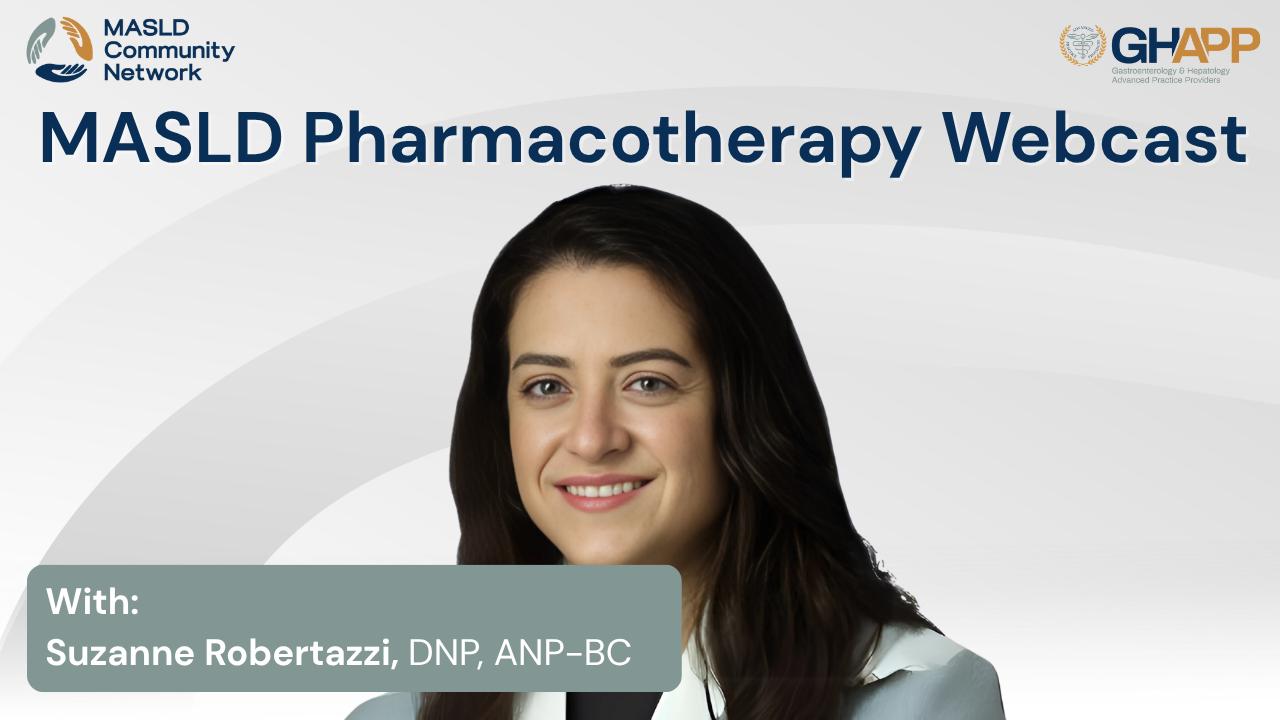
MASLD Pharmacotherapy With Suzanne Robertazzi

Join Suzanne Robertazzi, DNP for a clinician-focused update on MASH and MASLD pharmacotherapy—what to treat, when to treat, and how to monitor. This talk reviews the shift to MASLD/MASH terminology, why management must target the entire metabolic syndrome (obesity, type 2 diabetes, hypertension, dyslipidemia, cardiovascular risk), and the practical role of weight loss (diet, physical activity, anti-obesity medications, bariatric surgery). Suzanne explains where GLP-1 receptor agonists fit (mechanism, expected benefits, GI/aspiration precautions and holding doses before procedures), clarifies that statins are safe in fatty liver, and summarizes legacy data and limitations for vitamin E and pioglitazone. She then covers the first FDA-approved therapy for non-cirrhotic MASH with F2–F3 fibrosis, resmetirom—including THR-β–selective mechanism, tolerability, key drug–drug interactions (and statin dose limits), and real-world considerations such as insurance requirements, staging with FIB-4 and FibroScan®/NITs, restaging cadence, and treatment duration. If you’re a GI/hepatology clinician or APP, this session delivers evidence-based, step-by-step guidance to streamline risk reduction, staging, and therapy for patients with MASLD/MASH.
Watch Now
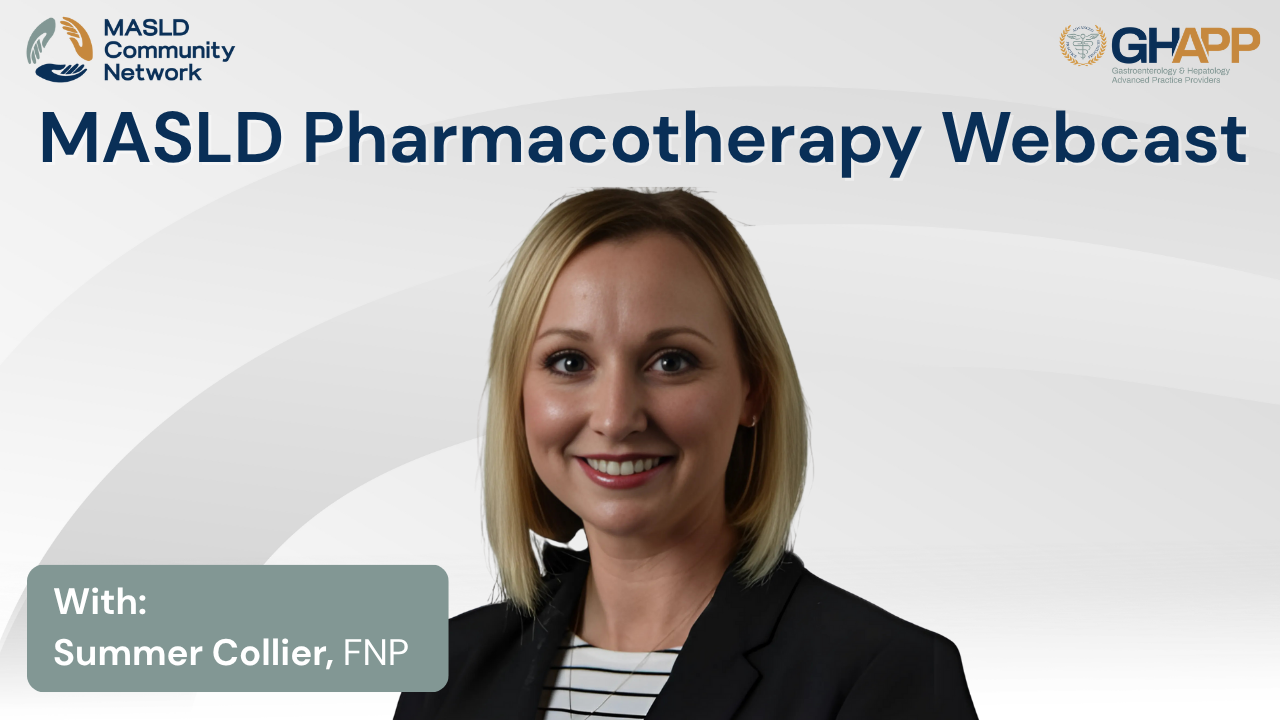
MASLD Pharmacotherapy With Summer Collier

Join Summer Collier, FNP, from UC San Diego Health, for a comprehensive discussion on pharmacotherapy for Metabolic Dysfunction-Associated Steatotic Liver Disease (MASLD) and MASH, presented through the GHAPP MASLD/MASH Community Network and sponsored by Madrigal Pharmaceuticals. In this session, Summer outlines the foundational role of lifestyle modification in treating MASLD, including diet, exercise, and weight loss, while emphasizing the growing need for liver-directed therapies in patients with moderate to advanced fibrosis. She reviews the clinical use of GLP-1 receptor agonists such as semaglutide and tirzepatide, which aid in glycemic control and significant weight loss, and explores their application in hepatology—including key data showing MASH resolution and fibrosis improvement. The discussion also addresses older treatment options like vitamin E and pioglitazone, explaining their risks, limitations, and patient selection criteria. The highlight of the presentation is a detailed analysis of resmetirom (Rezdiffra)—the first FDA-approved therapy for non-cirrhotic NASH with F2–F3 fibrosis. Summer walks through the MAESTRO-NASH trial, covering the mechanism of THR-β activation, improvements in liver histology, safety data, and practical prescribing guidance, including non-invasive monitoring, statin dose considerations, and drug–drug interactions. The session concludes with expert insights on staging, treatment duration, insurance access, and the evolving future of MASLD therapy. A must-watch for hepatology, GI, and primary care providers seeking to implement the latest evidence-based approaches in managing fatty liver disease.
Watch Now
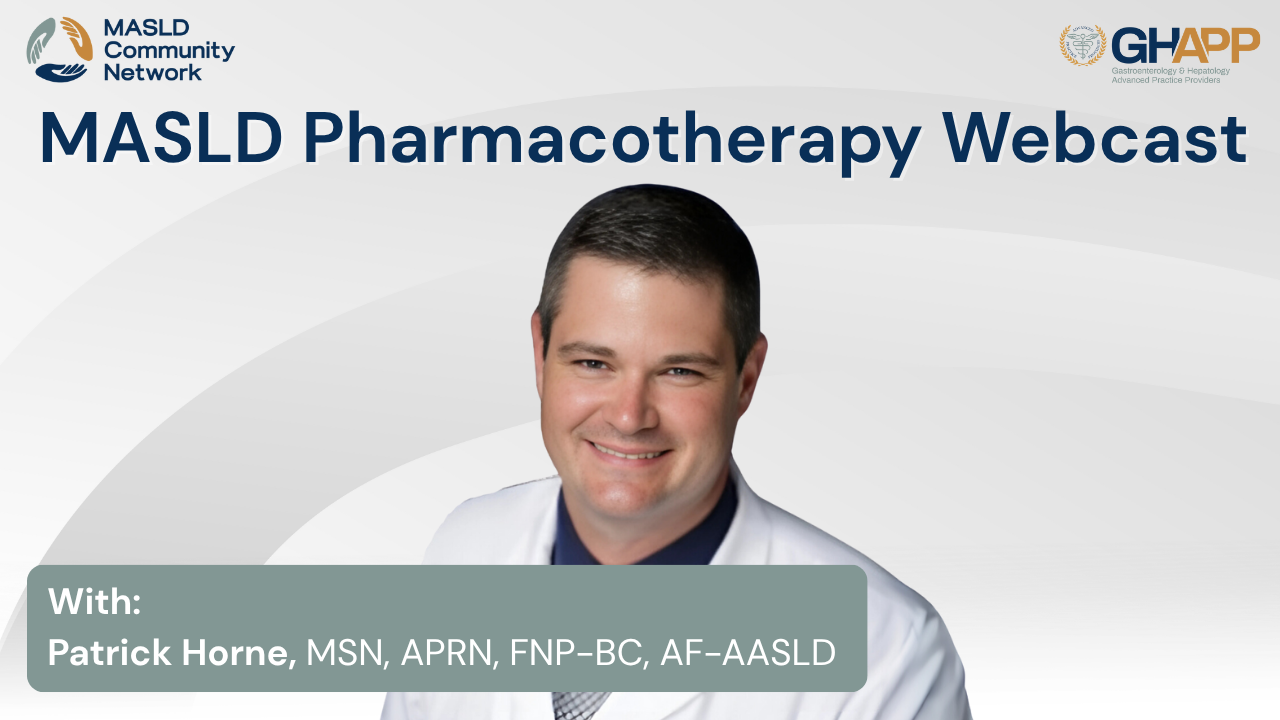
MASLD Pharmacotherapy With Patrick Horne

Join Patrick Horne, NP for a clear, clinic-ready overview of MASLD/MASH pharmacology—from the lifestyle backbone to cardiometabolic risk reduction and liver-directed therapies. Patrick breaks down where GLP-1 receptor agonists fit, reviews evidence and patient selection for vitamin E and pioglitazone, and spotlights resmetirom—the first FDA-approved THR-β agonist for non-cirrhotic MASH with F2–F3 fibrosis—including mechanism, key MAESTRO-NASH outcomes, common AEs (nausea/diarrhea), and practical drug–drug interactions. Walk away with a step-by-step approach to selecting therapy, setting measurable lifestyle goals, and using NITs to monitor response and guide duration—so you can confidently tailor treatment and improve outcomes.
Watch Now
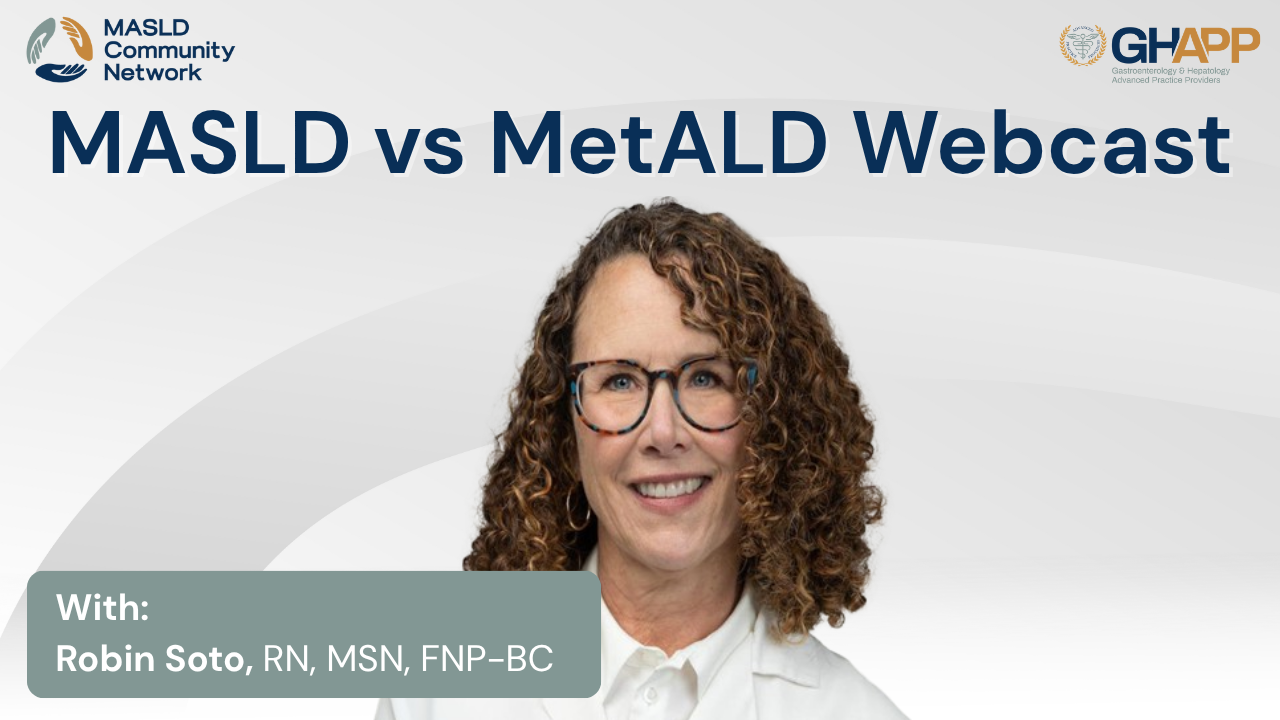
MASLD vs MetALD With Robin Soto

Robin Soto, NP, UC San Diego Health, delivers a clear, case-based overview of metabolic dysfunction–associated steatotic liver disease (MASLD), MASH, and mixed-etiology MET-ALD for the GHAPP MASLD Community Network. Using a common clinic scenario, she explains how to recognize steatotic liver disease, why getting an accurate alcohol history matters, and how non-invasive tools (e.g., FibroScan® and alcohol biomarkers) help confirm what’s driving liver injury. You’ll hear practical guidance on counseling patients—Mediterranean-style nutrition, sustainable weight loss, regular aerobic and resistance exercise, and alcohol reduction/abstinence—plus when to involve specialists and consider ongoing surveillance. Ideal for APPs and GI clinicians looking for a simple, patient-centered approach to preventing progression from fatty liver to advanced disease.
Watch Now





 July 2025
July 2025 